 W
WThe indigenous languages of Malaysia belong to the Mon-Khmer and Malayo-Polynesian families. The national, or official, language is Malay which is the mother tongue of the majority Malay ethnic group. The main ethnic groups within Malaysia are the Malays, Chinese and Indians, with many other ethnic groups represented in smaller numbers, each with its own languages. The largest native languages spoken in East Malaysia are the Iban, Dusunic, and Kadazan languages. English is widely understood and spoken in service industries and is a compulsory subject in primary and secondary school. It is also the main language spoken in most private colleges and universities. English may take precedence over Malay in certain official contexts as provided for by the National Language Act, especially in the states of Sabah and Sarawak, where it may be the official working language.
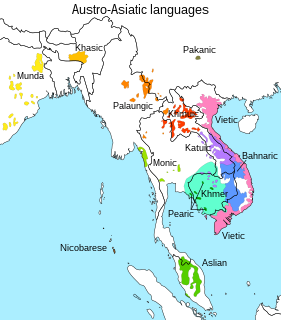 W
WThe Aslian languages are the southernmost branch of Austroasiatic languages spoken on the Malay Peninsula. They are the languages of many of the Orang Asli, the aboriginal inhabitants of the peninsula. The total number of native speakers of Aslian languages is about fifty thousand and all are in danger of extinction. Aslian languages recognized by the Malaysian administration include Kensiu, Kintaq, Jahai, Minriq, Batek, Cheq Wong, Lanoh, Temiar, Semai, Jah Hut, Mah Meri, Semaq Beri, Semelai and Temoq.
 W
WBahasa Rojak or Rojak language is a Malaysian pidgin formed by code-switching among two or more of the many languages of Malaysia. Bahasa means "language", while rojak means "mixture" in Malay, and is a local food of the same name.
 W
WBanjarese is an Austronesian language spoken by the Banjar people of South Kalimantan province of Indonesia. Since the Banjarese were historically nomadic merchants, Banjarese has been spoken throughout modern Indonesia and the Malay world.
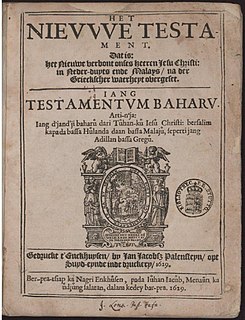 W
WBible translations into the languages of Indonesia and Malaysia have a lot of common history up until the modern era. Apart from the shared Malay language which historically was the lingua franca of the Malay archipelago and forms the basis for the national languages of Indonesia and Malaysia today, portions of the Bible have been translated into a variety of indigenous languages in the region.
 W
WBonggi (Banggi) is an Austronesian language spoken primarily by the Bonggi people of Banggi Island, off the northern tip of Sabah, Malaysia.
 W
WBisaya, also known as Southern Bisaya, Brunei Bisaya, Brunei Dusun or Tutong 1, is a Sabahan language spoken in Brunei and Sarawak, Malaysia.
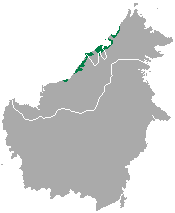 W
WBrunei Malay is the most widely spoken language in Brunei and a lingua franca in some parts of East Malaysia, such as Labuan, Limbang, Lawas, Sipitang and Papar. Though Standard Malay is promoted as the official language of Brunei, Brunei Malay is socially dominant and it is currently replacing the minority languages of Brunei, including the Dusun and Tutong languages. It is quite divergent from Standard Malay to the point where it is almost mutually unintelligible with it. Although the idea that Brunei Malay might be classified as a creole language has been discredited, it does bear considerable similarities to East Indonesian Malay-based creole languages.
 W
WBuginese or Bugis is a language spoken by about five million people mainly in the southern part of Sulawesi, Indonesia.
 W
WCantonese is a language within the Chinese (Sinitic) branch of the Sino-Tibetan languages originating from the city of Guangzhou and its surrounding area in Southeastern China. It is the traditional prestige variety of the Yue Chinese dialect group, which has over 80 million native speakers. While the term Cantonese specifically refers to the prestige variety, it is often used to refer to the entire Yue subgroup of Chinese, including related but largely mutually unintelligible languages and dialects such as Taishanese.
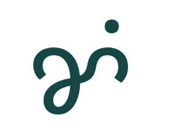 W
WCham is a Malayo-Polynesian language of the Austronesian family, spoken by the Chams of Southeast Asia. It is spoken primarily in the territory of the former Kingdom of Champa, which spanned modern Eastern Cambodia and Southern Vietnam. The Western variety is spoken by 220,000 people in Cambodia and 25,000 people in Vietnam. As for the Eastern variety, there are about 73,000 speakers in Vietnam, for a total of approximately 320,000 speakers.
 W
WCheq Wong is an Austroasiatic language spoken in the Malay Peninsula. It belongs to the Northern subbranch of the Aslian languages. Northern Aslian was labelled Jehaic in the past.
 W
WEastern Min or Min Dong, is a branch of the Min group of Sinitic languages of China. The prestige form and most-cited representative form is the Fuzhou dialect, the speech of the capital of Fujian.
 W
WHakka is a language group of varieties of Chinese, spoken natively by the Hakka people throughout Southern China and Taiwan and throughout the diaspora areas of East Asia, Southeast Asia and in overseas Chinese communities around the world.
 W
WHokkien is a Southern Min language originating from the Minnan region in the south-eastern part of Fujian Province in Southeastern Mainland China and spoken widely there. It is also spoken widely in Taiwan ; by the Chinese diaspora in Malaysia, Singapore, Indonesia, the Philippines and other parts of Southeast Asia; and by other overseas Chinese all over the world. The Hokkien 'dialects' are not all mutually intelligible, but they are held together by ethnolinguistic identity. Taiwanese Hokkien is, however, mutually intelligible with the 2 to 3 million speakers of the Amoy and Philippine dialects.
 W
WThe Iban language is spoken by the Iban, a branch of the Dayak ethnic group, who live in Brunei, the Indonesian province of West Kalimantan and in the Malaysian state of Sarawak. It belongs to the Malayic languages, a Malayo-Polynesian branch of the Austronesian language family.
 W
WThe Iranun language also Iranon, Illanun is an Austronesian language belonging to the Danao languages spoken in the provinces of Maguindanao and other part of Lanao del Sur and Lanao del Norte, coastal municipalities of Zamboanga del Sur from Tukuran to Dumalinao and Cotabato in southern Philippines and the Malaysian state of Sabah. It is the second most spoken language in Maguindanao after the Maguindanao language.
 W
WJah Hut is an Austroasiatic language spoken around the Krau river in peninsular Malaysia. The Jah Hut are one of the indigenous Orang Asli peoples.
 W
WJavanese ; Basa Jawa; Aksara Jawa: ꦧꦱꦗꦮ; Pegon: باساجاوا; Javanese pronunciation: [bɔsɔ d͡ʒɔwɔ]) is the language of the Javanese people from the central and eastern parts of the island of Java, in Indonesia. There are also pockets of Javanese speakers on the northern coast of western Java. It is the native language of more than 98 million people.
 W
WKelabit is one of the most remote languages of Borneo, on the Sarawak–North Kalimantan border. It is spoken by one of the smallest ethnicities in Borneo, the Kelabit people.
 W
WLun Bawang or Lundayeh is the language spoken by the Lun Bawangs. It belongs to the Malayo-Polynesian family.
 W
WMadurese is a language of the Madurese people of Madura Island and Eastern Java, Indonesia; it is also spoken on the neighbouring small Kangean Islands and Sapudi Islands, as well as by migrants to other parts of Indonesia, namely the eastern salient of Java, the Masalembu Islands and even some on Kalimantan. The Kangean dialect may be a separate language. It was traditionally written in the Javanese script, but the Latin script and the Pegon script is now more commonly used. The number of speakers, though shrinking, is estimated to be 8–13 million, making it one of the most widely spoken languages in the country. Bawean, a variant of Madurese, is also spoken by Baweanese descendants in Malaysia and Singapore.
 W
WMalay is an Austronesian language officially spoken in Indonesia, Brunei, Malaysia and Singapore and unofficially spoken in East Timor and parts of Thailand. It is spoken by 290 million people across the Malay world.
 W
WKedah Malay or Kedahan or as it is known in Thailand, Syburi Malay is a variety of the Malayan languages mainly spoken in the northwestern Malaysian states of Perlis, Kedah, Penang, and northern Perak and in the southern Thai provinces of Trang and Satun. The usage of Kedah Malay was historically prevalent in southwestern Thailand before being superseded by the Thai language. Enclaves of Kedah Malay can be found in Kawthaung District in Myanmar; Ranong and Krabi in upper southern Thailand; Jaring Halus, Langkat and Acheh in Sumatra, Indonesia and up north in Bangkok, central Thailand, where most of the Kedah Malay speakers are descendants of historical settlers from Kedah.
 W
WThe Malayic languages are a branch of the Malayo-Polynesian subgroup of the Austronesian language family. The most prominent member is Standard Malay, which is the national language of Brunei, Singapore and Malaysia; it further serves as basis for Indonesian, the national language of Indonesia. The Malayic branch also includes the local languages spoken by ethnic Malays, further several languages spoken by various other ethnic groups of Sumatra and Borneo. The most probable candidate for the urheimat of the Malayic languages is western Borneo.
 W
WMandarin is a group of Sinitic (Chinese) languages natively spoken across most of northern and southwestern China. The group includes the Beijing dialect, the basis of the phonology of Standard Chinese. Because Mandarin originated in North China and most Mandarin dialects are found in the north, the group is sometimes referred to as Northern Chinese. Many varieties of Mandarin, such as those of the Southwest and the Lower Yangtze, are not mutually intelligible or are only partially intelligible with the standard language. Nevertheless, Mandarin is often placed first in lists of languages by number of native speakers.
 W
WMaranao is an Austronesian language spoken by the Maranao people in the provinces of Lanao del Norte and Lanao del Sur in the Philippines, and in Sabah, Malaysia.
 W
WMinangkabau is an Austronesian language spoken by the Minangkabau of West Sumatra, the western part of Riau, South Aceh Regency, the northern part of Bengkulu and Jambi, also in several cities throughout Indonesia by migrated Minangkabau. The language is also a lingua franca along the western coastal region of the province of North Sumatra, and is even used in parts of Aceh, where the language is called Aneuk Jamee.
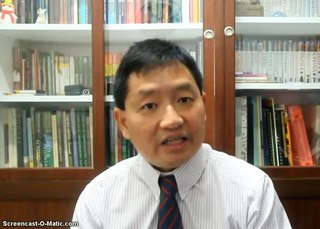 W
WPenang Hokkien is a local variant of Hokkien spoken in Penang, Malaysia. It is spoken as a mother tongue by 63.9% of Penang's Chinese community, and also by some Penangite Indians and Penangite Malays.
 W
WThe Philippine languages, also called the Philippinic languages, are a proposed group by R. David Paul Zorc (1986) and Robert Blust that include all the languages of the Philippines and northern Sulawesi—except Sama–Bajaw and a few languages of Palawan—and form a subfamily of Austronesian languages. Although the Philippines is near the center of Austronesian expansion from Formosa, there is little linguistic diversity among the approximately 150 Philippine languages, suggesting that earlier diversity has been erased by the spread of the ancestor of the modern Philippine languages.
 W
WPuxian, also known as Pu-Xian Chinese, Puxian Min, Xinghua, Henghwa or Hinghwa, is a Sinitic language that forms a branch of Min Chinese.
 W
WThe Sama language, Sinama, is the language of Sama-Bajau people of the Sulu Archipelago, Philippines; Sabah, Malaysia and parts of Indonesia. The Sama are one of the most widely dispersed peoples in Southeast Asia.
 W
WSouthern Min, Minnan or Banlam, is a group of linguistically similar and historically related Sinitic languages that form a branch of Min Chinese spoken in Fujian, most of Taiwan, Eastern Guangdong, Hainan, and Southern Zhejiang. The Minnan dialects are also spoken by descendants of emigrants from these areas in diaspora, most notably the Philippines, Indonesia, Malaysia, Singapore, San Francisco, Los Angeles and New York City. It is the most populous branch of Min Chinese, spoken by an estimated 48 million people in ca. 2017–2018.
 W
WSouthern Malaysian Hokkien is a local variant of the Min Nan Chinese variety spoken in Central and Southern Peninsular Malaysia, Singapore, Riau and Riau Islands
 W
WTamil is a Dravidian language natively spoken by the Tamil people of South Asia. Tamil is an official language of the sovereign nations of Sri Lanka and Singapore, the Indian state of Tamil Nadu, and the Union Territory of Puducherry. Tamil is spoken by significant minorities in the four other South Indian states of Kerala, Karnataka, Andhra Pradesh and Telangana and the Union Territory of the Andaman and Nicobar Islands. It is also spoken by the Tamil diaspora found in many countries, including Malaysia, Myanmar, South Africa, United Kingdom, United States, Canada, Australia and Mauritius. Tamil is also natively spoken by Sri Lankan Moors.
 W
WTausug is an Austronesian language spoken in the province of Sulu in the Philippines and in the eastern area of the state of Sabah, Malaysia, by the Tausūg people. It is widely spoken in the Sulu Archipelago, the Zamboanga Peninsula, southern Palawan and Malaysia.